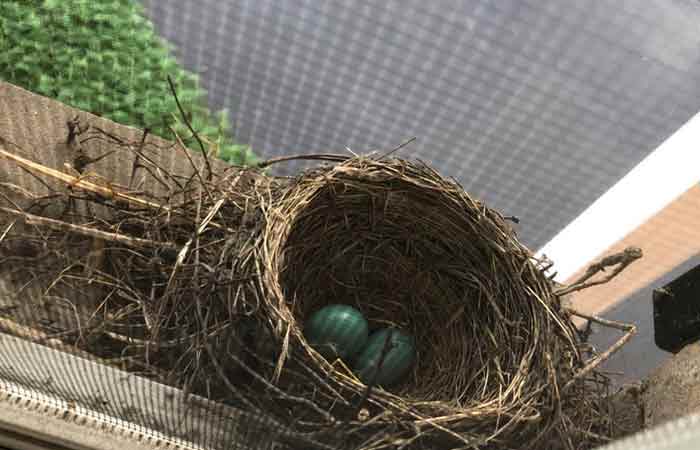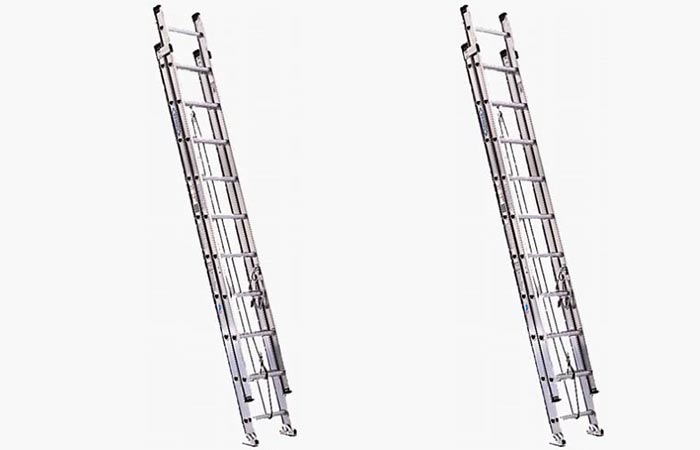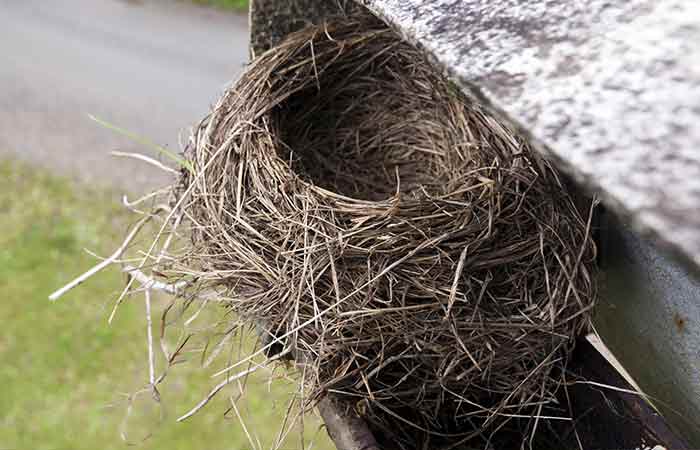Birds love nesting on rooftops and one of their favorite places is the gutter given how easy it is to make a nest there. The curved shape of gutters makes it much easier for the birds to make a nest. However, these nests are an issue as they can easily lead to clogs when they end up in the opening of the gutter’s downspout. The presence of birds on the roof can also invite snakes which come to eat them and their young ones and the eggs too.
To get rid of birds’ nest simply reach to the gutter and either pull it out of the gutter or, if it’s deep inside the downspout, flush it down with water under pressure.
You should however remove the nest without harming the birds. Just so you know, there are laws that protect the birds to the extent that killing them or evicting them without care can land you into legal problems. You should remove the nest when it is inactive; that is when it’s either being built or at the end of the nesting season.
While at it, make sure you take care of yourself so that you don’t get injured while climbing the roof. Also, be careful with touching birds and their nests as they can harm you with pecks, scratches or infect you with diseases and even mites and fleas. Lastly, look out for snakes which also come into the nests to hunt the birds down.
Steps to remove birds’ nests from the gutter
You need to carry out an inspection of your roof to determine if indeed there are birds’ nests there.
What you need
The supplies for this task include these items:
- Rubber gloves
- Ladder
- Trowel or other type of scooper
- Bucket
The steps to removing the nests from your gutters are as follows:
1. Inspect the gutter for nests
If you see birds frequenting your roof, there is a high likelihood that they are nesting on it. Another sign is that the roof may be harboring bird nests is a clog in the gutter. Such a clog can easily damage the roof to the extent that the gutter can break or bend under the weight of the water.

Simply take a ladder then climb to the height of the gutters. Make sure you protect yourself with gloves and goggles. Check the whole gutter especially in the joints and corners of the gutter for nests. Birds often have their nests exposed while rodents tend to put them inside hidden places such as the downspouts of the gutters.
2. Position the ladder accordingly
After you inspect the gutter and find the nest, you should then put the ladder directly under the nest if possible. For safety purposes, you can have the ladder slightly to one side just in the case something comes out of the nest and attacks you. The space can allow you protect yourself from the attack be it from a snake or bird.
Always observe the safety procedures for using ladders such as the following:
- Always work from the ladder and only climb the roof as a last resort. Since you’re working on the gutters, you don’t need to climb the roof to access the nests.
- Wear protective gear such as gloves and goggles to keep the dirt from the nests at bay. The gloves should be rubber ones which give you grip when handling the ladder and roof.
- Before going up the ladder, inspect all its parts to ensure it still works fine if you want to use it. Don’t use it if it has any broken or weakened parts.
- If you have the fear of heights, only climb the ladder to a height you still feel safe.
- Only climb the ladder when it’s dry unless absolutely necessary. Otherwise, only use a dry ladder which doesn’t pose the risk of slipping and falling.
- Put the ladder at a good angle from the roof to avoid falling backward. You can also try ladder stabilizers for more stability
- Make sure the feet of the ladder are positioned on solid ground to avoid falls.
With these aspects in mind, go to the next step.
3. Climb the ladder to reach the nests
You can use either an extension ladder or a stepladder to reach the roof where the nests are located. After reaching it, inspect it further preferably with a stick to make sure the nest has no birds in it. check for eggs and young birds as well. If you find any of these, don’t remove the nest. If none of them are there, head over to the next step.

Further Reading: Best Ladders for Gutter Cleaning
4. Remove the nest
With your gloves and goggles still on, simply pull the nest out of the gutter then throw it into a bucket or some other container. You can also simply scoop it up with a trowel or other small tool for more safety.

5. Clean the gutter and downspout
This is a great chance to wash away the dirt and debris in the gutter and downspouts. You will first need to remove the debris from the gutter, unclog the downspouts then give them a thorough cleaning.
If the nest in question is inside the downspout, chances are high that it’s a rodent’s nest and not one built by a bird. In such a case, you will have to poke it to tear it apart then flush large amounts of water down the downspout to get rid of it.
Ideas to keep birds away from your gutter and roof
You can also keep the birds away from the gutter and roof in general with the following ideas:
Aluminum gutter covers
Aluminum gutter covers do wonders to your gutters as they keep lots of things out of them. For example, birds won’t get a chance to nest in the gutters and leaves, twigs and any other debris won’t clog up the gutters. Gutters are for collecting water and rain water is the only thing allowed into the gutters by these gutter covers.
Steel mesh (hardware cloth)
Having a steel mesh over the gutters does the same job as aluminum gutter covers as they keep objects out of the gutter. The result is that even birds will find it hard building nests in the gutters as the steel mesh keeps them out.
Trapping and relocating the birds
This is one of the most unpredictable methods as it entails trapping the birds on your roof and relocating them to other areas. The problem is that you can’t tell if the birds will come back or not. In most cases, the same bird will keep on coming and building a nest until it gives up or the nesting season is over. Still, it’s very humane and encouraged.
Sound deterrence
This method relies heavily on technology as you need to scare the birds away with sounds such as those from predators or high frequency ones that are annoying to the birds.
The predator sounds can be quite annoying even to you as the owner of the house and thus not very much encouraged. On the other hand, the high frequency sounds won’t be heard by people but birds only since that frequency is not audible to humans.
Install decoys
Decoys such as plastic birds of prey or scarecrows can be installed on the roof to keep out the birds. You’re better off going for decoys which move about in the wind to act like they’re moving as they’re more effective at chasing the nesting birds. Some housing associations may not allow these scarecrows however.
Using bird repellent
Bird repellent is a smell existing as a gel, spray or granules which can be put on the roof and is undesirable to birds. Bird repellent is quite effective especially when you’re dealing with lots of birds nesting on your roof. Just make sure the repellent doesn’t harm the environment.
Install rubber snakes
Another type of decoy that works wonders is a plastic or rubber snake. Birds know snakes eat birds, their chicks and their eggs as well. Simply tie the snake on the roof such that the rain doesn’t wash it down and where birds can see it to keep off.
Attack Spider
Attack Spider is a commercial solution made of an 18-inch line which detects movement on the roof then drops down a large spider on a line to scare the birds. Birds are aware that large spiders eat birds and wont dare nest on a roof with a large spider.
Foil tapes
Foil tapes tied on the roof and left to fly in the wind are quite effective as they reflect light and make frightening noises which won’t affect those living in the house but will chase away the birds. If you don’t have foil tape, use the little tape found in cassettes.
Bird spikes
To deter birds from landing on your roof and getting comfortable, add bird spikes on the roof as they will prick the birds each time they try to land on the roof. Place them on the ridges of the roof and around the gutters for the best results.
Copper mesh
Copper mesh can be placed on the open holes on the roof close to the gutters and in ventilation holes to keep the birds away while still allowing the air and water to pass through.
Make sure you frequently check these holes for any collected debris as they may clog up if not cleaned frequently enough.
These methods should help keep birds away from your gutters and the roof as a whole.
Clogged gutters are a headache to deal with as they lead to moisture damage on the house, drainage issues, pests like mosquitoes breed faster with sedentary water, and the gutters can collapse with time.
As an Amazon Associate, we earn from qualifying purchases. Details here
